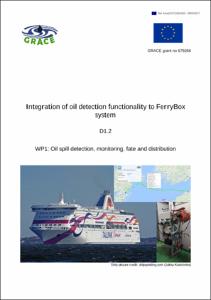| dc.contributor.author | Pärt, Siim | |
| dc.contributor.author | Kõuts, Tarmo | |
| dc.contributor.author | Vahter, Kaimo | |
| dc.coverage.spatial | Baltic Sea | en_US |
| dc.date.accessioned | 2022-06-07T15:29:54Z | |
| dc.date.available | 2022-06-07T15:29:54Z | |
| dc.date.issued | 2017 | |
| dc.identifier.citation | Pärt, S., Kõuts, T. and Vahter. K. (2017) Integration of oil detection functionality to FerryBox system, Version 1.2. GRACE WP1, D1.2. Finnish Environment Institute (SYKE), 39pp. DOI: http://dx.doi.org/10.25607/OBP-1761 | en_US |
| dc.identifier.uri | https://repository.oceanbestpractices.org/handle/11329/1949 | |
| dc.identifier.uri | http://dx.doi.org/10.25607/OBP-1761 | |
| dc.description.abstract | Our knowledge of the ocean is limited by our observational ability. To better understand and
manage the oceans and the coastal systems, there is a clear need for environmental data of higher
spatial and temporal resolution. Long-term operation of FerryBox systems has demonstrated the
reliability and cost-effectiveness of such systems for observing the state of the ocean and seas over
a wide range of temporal and spatial scales. There is great potential for data coverage using ferries
and cargo ships of opportunity (SOOP) cruising on the same route on a regular basis, especially in
coastal regions. It is fair to say that FerryBox systems have, reached reliability status. The installed
systems can integrate data from water quality and meteorological sensors with GPS information
into a data stream that is automatically transferred from ship to shore. Different applications reveal
the usefulness of FerryBox measurements not only for monitoring purposes but for scientific
questions as well.
There is still a particular lack of robust biogeochemical observations in the oceans and especially in
the coastal regions with their high biological activity. Numerous promising technologies for betterautomated
measurements of different biologically relevant parameters are under development, or
are even at a mature stage. FerryBoxes are ideal platforms to integrate such a sensor systems, even
if they are in the development stage, as they offer a protected environment and easy access for
maintenance and other issues.
In general, all FerryBox systems employ a quite similar basic design. The system consists of a water
inlet from where the water is pumped into the measuring circuit containing multiple sensors. A
basic system includes usually sensors for temperature, salinity, turbidity and chlorophyll-a
fluorescence, and a GPS receiver for position control. Data is transmitted to shore via GSM/GPRS
connection or satellite communication.
Marine Systems Institute at Tallinn University of Technology has maintained FerryBox on ferry
M/S ROMANTIKA for over three years, between Riga-Stockholm and later Tallinn-Stockholm.
During that time, many different parameters like temperature, salinity, chlorophyll-a etc. were
continuously measured and the results could be seen online in real time. In the end of 2016 M/S
ROMANTIKA was replaced with MS/ BALTIC QUEEN and the FerryBox system with some
modification and oil detection capability, reinstalled to the ship. Data is represented on a webpage
http://on-line.msi.ttu.ee/GRACEferry/.
Preliminary results of PAH measurements with FerryBox system on M/S BALTIC QUEEN on the
route Tallinn-Stockholm-Tallinn (05.02.2017-14.02.2017) showed good data quality - PAH
concentration varied between 0.014 μg/l and 0.093 μg/l. Differences in PAH concentrations
between coastal areas and open sea could be seen. | en_US |
| dc.description.sponsorship | European Commission, Contract n° 679266
Horizon 2020 BG-2014-2015/BG2015-2 | en_US |
| dc.language.iso | en | en_US |
| dc.publisher | Finnish Environment Institute (SYKE) for GRACE Project | en_US |
| dc.subject.other | FerryBox | en_US |
| dc.subject.other | SOOP | en_US |
| dc.subject.other | Ships of Opportunity | en_US |
| dc.subject.other | Voluntary ships | en_US |
| dc.title | Integration of oil detection functionality to FerryBox system. GRACE WP1, D1.2. Verson 1.2. | en_US |
| dc.type | Report | en_US |
| dc.description.status | Published | en_US |
| dc.format.pages | 39pp. | en_US |
| dc.description.refereed | Refereed | en_US |
| dc.subject.parameterDiscipline | Physical oceanography | en_US |
| dc.subject.instrumentType | CTD | en_US |
| dc.subject.dmProcesses | Data acquisition | en_US |
| dc.subject.dmProcesses | Data processing | en_US |
| dc.description.currentstatus | Current | en_US |
| dc.description.sdg | 14.a | en_US |
| dc.description.maturitylevel | Mature | en_US |
| dc.description.adoption | Validated (tested by third parties) | en_US |
| dc.description.adoption | Multi-organisational | en_US |
| dc.description.adoption | International | en_US |
| dc.description.sensors | FerryBox | en_US |
| dc.description.methodologyType | Reports with methodological relevance | en_US |
| obps.contact.contactemail | tarmo.kouts@msi.ttu.ee | |
| obps.resourceurl.publisher | https://www.grace-oil-project.eu/en-US/About/Deliverables | |
 Repository of community practices in Ocean Research, Applications and Data/Information Management
Repository of community practices in Ocean Research, Applications and Data/Information Management
